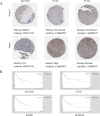Paraptosis-related classification and risk signature for prognosis prediction and immunotherapy assessment in gastric cancer
- PMID: 40524099
- PMCID: PMC12170466
- DOI: 10.1007/s12672-025-02996-0
Paraptosis-related classification and risk signature for prognosis prediction and immunotherapy assessment in gastric cancer
Abstract
Background: Gastric cancer (GC) poses a significant health threat due to its prevalence and poor prognosis. To improve outcomes, there is an urgent need for novel biomarkers. Paraptosis, a recently discovered form of programmed cell death, remains uninvestigated in GC, and understanding its mechanisms could offer new insights.
Materials and methods: In our study, we utilized the TCGA-STAD dataset as the training cohort and GSE84433 as the validation cohort to explore the association between paraptosis-related genes and the clinical risk of gastric cancer (GC). Our goals were to analyze the prognostic value and potential biological mechanisms of these genes. We conducted various analyses, including consistent clustering, differential gene expression analysis, enrichment analysis, and immune infiltration analysis. Ultimately, we developed a paraptosis-related risk signature (PRRS) to assess survival prognosis, drug sensitivity, and immune infiltration based on risk classification. The reliability of our findings was further verified through immunohistochemical staining.
Results: Our results revealed distinct subgroups (C1, C2, and C3) among gastric cancer patients through consensus clustering based on 65 paraptosis-related genes. These subgroups exhibited significant variations in survival rates, immunity scores, and immune cell infiltration. We then developed the Paraptosis-Related Risk Score (PRRS) using cox-lasso regression analysis, incorporating genes such as SLCO2A1, VCAN, RAMP1, and MANEAL. The PRRS effectively distinguished between high-risk and low-risk populations. Validation in an independent dataset and immunohistochemical staining confirmed the accuracy of the PRRS. These findings highlight the close relationship between paraptosis and the immune microenvironment of gastric cancer tumors, and demonstrate the PRRS's robust performance in predicting patient survival.
Conclusion: This study underscores the link between paraptosis subtypes and changes in the gastric cancer immunotumour microenvironment. We developed and validated the Paraptosis-Related Risk Score (PRRS), which effectively predicts survival, immune infiltration, and drug sensitivity in gastric cancer patients. Our findings enhance the understanding of paraptosis and suggest potential new therapeutic strategies for gastric cancer.
Keywords: Classification; Gastric Cancer; Immunotherapy; Paraptosis; Prognosis.
© 2025. The Author(s).
Conflict of interest statement
Declarations. Ethical approval: Not applicable. All the data involved in this study were obtained from an open platform, no ethical permission was required. It is complying with the specific requirements of country. Competing interests: The authors declare no competing interests.
Figures









Similar articles
-
Development and validation of a Log odds of negative lymph nodes/T stage ratio-based prognostic model for gastric cancer.Front Oncol. 2025 Jun 3;15:1554270. doi: 10.3389/fonc.2025.1554270. eCollection 2025. Front Oncol. 2025. PMID: 40530015 Free PMC article.
-
Comprehensive pan-cancer analysis reveals NTN1 as an immune infiltrate risk factor and its potential prognostic value in SKCM.Sci Rep. 2025 Jan 25;15(1):3223. doi: 10.1038/s41598-025-85444-x. Sci Rep. 2025. PMID: 39863609 Free PMC article.
-
The impact of de novo lipogenesis on predicting survival and clinical therapy: an exploration based on a multigene prognostic model in hepatocellular carcinoma.J Transl Med. 2025 Jun 18;23(1):679. doi: 10.1186/s12967-025-06704-y. J Transl Med. 2025. PMID: 40533802 Free PMC article.
-
Enhancing the diagnostic potential of electroretinography in Parkinson's disease: A review of protocol and cohort criteria.J Parkinsons Dis. 2025 Jun;15(4):694-709. doi: 10.1177/1877718X251331863. Epub 2025 Apr 29. J Parkinsons Dis. 2025. PMID: 40530583 Review.
-
Defining disease severity in atopic dermatitis and psoriasis for the application to biomarker research: an interdisciplinary perspective.Br J Dermatol. 2024 Jun 20;191(1):14-23. doi: 10.1093/bjd/ljae080. Br J Dermatol. 2024. PMID: 38419411 Free PMC article. Review.
References
LinkOut - more resources
Full Text Sources
Miscellaneous
